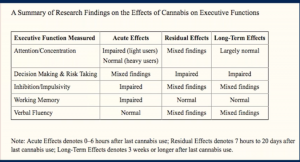[The following notes were generated by Michele Haight, PhD.]
IAMSE Webinar Series, Winter 2020
Speakers: Lee Jones
Title: “Medical Students and Substance Use: Challenges and Supports”
Series: How is Health Science Education Tackling the Opioid Epidemic?
- According to a 2019 CBS News Poll, views and opinions towards marijuana in the US are changing with a trend toward legalizing marijuana.
- Marijuana is the most commonly used psychotropic drug by young adults in the US, second only to alcohol.
- Effects of marijuana use:
- Smoking has immediate effects that last 1-3hrs. Peak levels of intoxication for smoking marijuana occur 30 minutes after smoking and last for several hours.
- GI ingestion effects occur within 30-60 min. and last “many hours.” This poses a greater risk for overdose.
- THC is detected almost immediately in the bloodstream. It is fat-soluble and able to be detected in the urine anywhere from one day to more than a month after ingestion.
- Common effects of Marijuana include:
- Euphoria
- Sense of relaxation
- Altered senses/altered sense of time
- Changes in mood
- Impaired body movement
- *Difficulty thinking and problem-solving
- *Impaired memory
- Hallucinations (heavy use)
- Delusions (heavy use)
- Psychosis (heavy use)
* Of concern for physicians/physician trainees
- Drug Detection Time in the Urine:
- Single use. 3 days
- Moderate use 5-7 days
- Chronic use (daily) 10-15 days
- Chronic heavy smoker >30 days (after cessation)
- In the US, there are currently 2 FDA-approved THC medications : Dronabinol/Marinol and Nabilone. Dronabinol tests positive for THC on urine tests but Nabilone tests negative for THC.
- According to Crean et al. (2011), marijuana impairs cognitive functions on many levels including basic motor coordination and more complex executive function tasks. These deficits vary depending on the quantity, recentness, age of onset and duration of the marijuana use.
- Summary of research findings on the effects of cannabis (Crean et al., 2011)
 The table shows mixed findings based on the types of effects, acute, residual or long-term as well as the focused area of executive functioning.
The table shows mixed findings based on the types of effects, acute, residual or long-term as well as the focused area of executive functioning.
- Cannabis Use Disorder/Cannabis Withdrawal Disorder are included in the DSM-5.
- According to Hasin et al. (2015), nearly 30 % of marijuana users manifested a marijuana use disorder between 2012 and 2013.
- Marijuana laws vary by state. Currently, 26 states plus DC have decriminalized small amounts of marijuana. Eleven states and DC have legalized recreational marijuana. However, institutions that receive federal research or financial aid monies must have policies that comply with federal drug laws that consider marijuana illegal.
- Marijuana is a DEA Schedule 1 Substance. Physicians cannot legally prescribe a Schedule 1 controlled substance.
- The Federation of Sate Medical Boards (FSMB) “…advise their licensees to abstain from the use of marijuana for medical or recreational purposes while actively engaged in the practice of medicine…”
- Physician trainee issues with medical and recreational marijuana:
- ADA protections for protected disabilities do not extend to the use of non-FDA approved medications (marijuana). Graduates have been granted ADA protections if pre-employment drug screens were positive for an FDA-approved medication (Dronabinol/Marinol).
- Institutions that employ residents are within their rights to deny employment because of a positive cannabinoid screen for marijuana use.
- Matching in a state that has legalized medical and/or recreational marijuana does not protect graduates from adverse consequences (such as Match revocation) related to the use of legalized and/or medical marijuana.
- An increasing number of clinical rotations, including medical school clinical sites, are requiring substance abuse screening, including marijuana.
- It might be worthwhile to explore with one’s treating clinician FDA-approved treatments instead of medical marijuana.
- For practicing physicians, even if a state approves of medical and recreational marijuana use, other institutions within the state might still require a negative test for marijuana.
- Second-hand marijuana smoke exposure can produce a positive screening result, depending on the amount of time of exposure. However, a more recent study indicates that a positive screening for second-hand marijuana smoke is not likely.
- Repeated dissemination of information to medical students related to potential consequences of medical and/or recreational marijuana use and the Match is done at UCSF SOM and is highly recommended for all medical schools.
- The article referenced below provides a guide for developing support systems for substance use disorders in physician training.
“A Lethal Hidden Curriculum — Death of a Medical Student from Opioid Use Disorder.” Catherine R. Lucey, M.D., Lee Jones, M.D., and Abigail Eastburn, M.D. August 29, 2019, N Engl J Med 2019; 381:793-795. DOI: 10.1056/NEJMp1901537